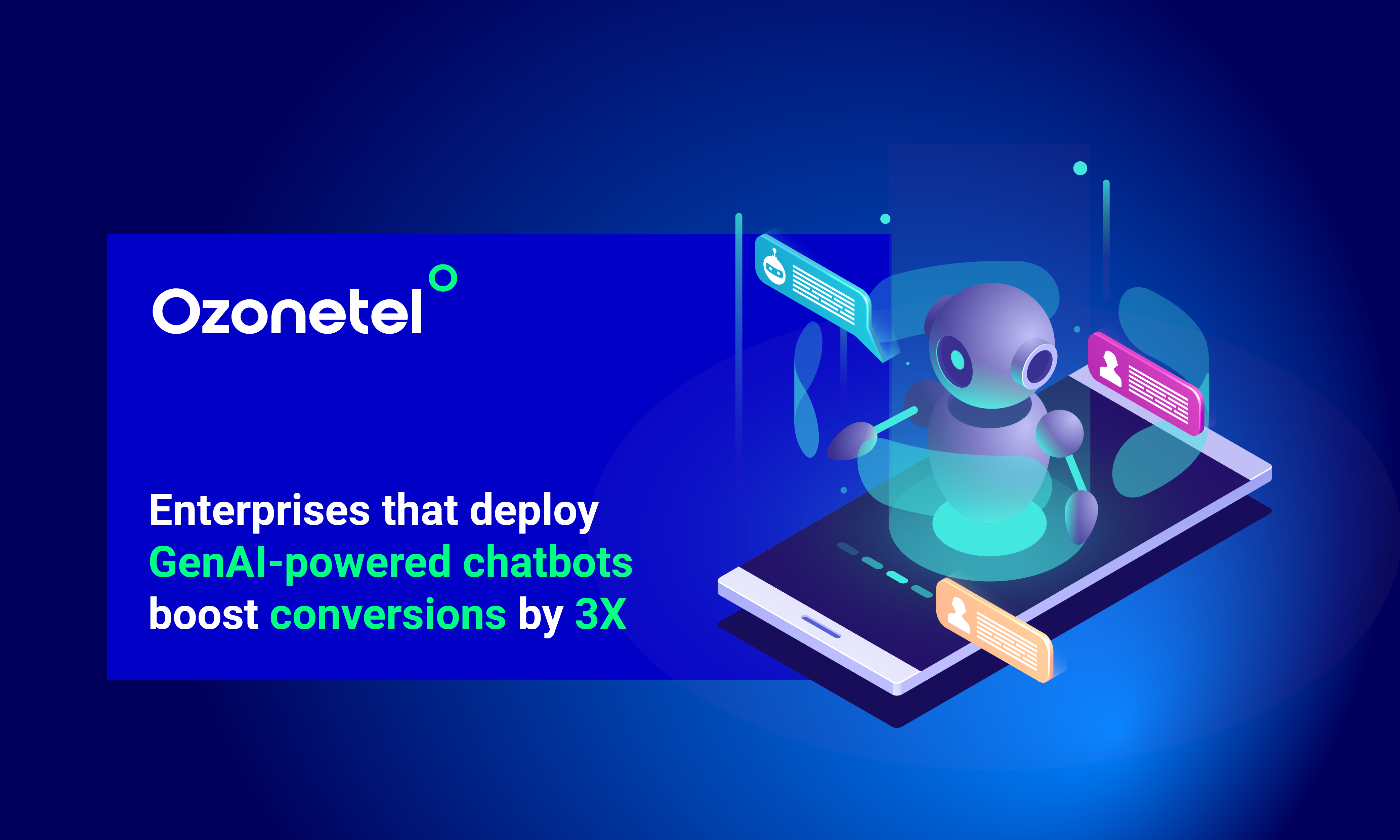- Resources
- How to Create a Seamless Self-service Experience with Digital Bot Designer
How to Create a Seamless Self-service Experience with Digital Bot Designer

No-code chatbots are one of the most significant technological innovations that have shifted the paradigm and enabled even tiny businesses to use chatbots. In fact, research predicts that by 2024, chatbots will save organizations up to 2.5 billion hours of work.
How? No-code chatbots are built using an intuitive digital bot designer, offering simple drag-and-drop options allowing users to effortlessly meet their chatbot requirements. With the advent of GenAI solutions, organizations can now offer superior self-service experiences with intelligent and personalized interactions at scale. It levels the playing field, enabling large and small organizations to create chatbots without needing a large crew. These chatbots are simple to create, deploy, and maintain.
No-code solutions even provide templates for various jobs such as lead generation, customer support, product recommendations, surveys, etc. No-code is about making chatbot technology simple and accessible to everyone.
Continue reading as we discuss no-code chatbots, including their benefits, use cases, pros and cons, and how to build one.
In this article, we will explore:
- 1. What Is No Code Chatbot?
- 2. Benefits of No Code Chatbots for Businesses
- 3. Challenges to Seamless Digital CX
- 4. Ensuring Seamless Self-service with Digital Bot Designer
- 5. How to Build Your No Code Chatbots
- 6. How Ozonetel's Digital Bot Designer Simplifies Building Chatbots
- 7. No Code Chatbots Use Cases
- 8. Trends in No Code Chatbot
What Is No Code Chatbot?
No-code development is a style of web development in which anyone, including non-developers, can create software on the web using a visual interface rather than writing code. It transforms the fundamentals of code into easy solutions that do not require any programming language knowledge. The individuals who create the tools must know how to code, but you do not!
Similarly, a no-code chatbot is an automated conversational agent that can be integrated into a web, mobile, or backend application without coding. Using no-code tools to create a chatbot allows developers, non-technical users, and company executives to design, develop, and deploy an interactive, natural language-driven chatbot in a fraction of the time it would take to build one from scratch with traditional programming languages and frameworks.
Benefits of No Code Chatbots for Businesses

Using no-code platforms, you can create chatbots faster than if you build them from scratch. As most of the building blocks will already be available on the platform, you can concentrate on important business aspects that improve the chatbots’ performance. Also, your development team does not need to focus on basic features that provide no competitive advantage but are required for the bots’ smooth operation.
Here are a few more benefits of no-code chatbots for businesses:
Saves Time and Cost
The lower cost and time investment for no-code chatbots is a significant advantage, particularly for smaller enterprises or those with limited resources. Traditional code can be complex and costly, necessitating continuing developer support. No-code platforms make this process easier, frequently incorporating simple tools for upgrades and maintenance, minimizing the requirement for ongoing developer engagement and associated expenses.
Ease of Deployment
No Code Chatbots can be built quickly and easily without substantial coding experience. With a user-friendly visual interface, you can interact with pre-designed templates or modules effortlessly. This simplicity makes the development process straightforward and accessible to everyone, ensuring that deploying your chatbot is smooth and hassle-free. Non-technical users can design, deploy, and manage chatbots independently, reducing the workload on IT teams. This can free up technical resources for more complex projects.
Flexible and Customizable
No-code chatbot development systems provide customers with high flexibility and customization when creating chatbots without coding. Users can simply design and update their chatbots with a visual interface that lets them drag and drop pieces, select prebuilt templates, and link with other applications. Users can customize the chatbot’s appearance, personality, language, and logic to match their brand and target demographic.
Consistency
No-code chatbot development platforms also ensure that firms provide a uniform user experience across all chatbot services. They provide the resources to construct chatbots consistent with a company’s brand image and customer service requirements, increasing overall customer satisfaction.
Users can tailor the chatbot’s appearance, personality, language, and logic to their company identity and target audience. For example, a company can utilize a no-code chatbot creation platform to build a chatbot that reflects its brand voice and tone, uses suitable greetings and emojis, provides clear and useful responses, and gracefully handles failures and fallbacks.
Compliance and Security
Compliance and security in no-code chatbots are important, especially given the growing worries about data privacy and legal compliance. Establishing compliance and robust security in traditional development can be difficult and time-consuming.
On the other hand, no-code chatbots provide a more streamlined and secure solution. They are built with compliance in mind, meeting various industry standards and requirements. No-code chatbot systems frequently include powerful data encryption and secure data handling techniques built-in. Moreover, chatbots can be built to comply with regulations such as HIPAA and PCI DSS, providing features and functionalities tailored to meet the stringent requirements of their respective sectors.
Enhanced Efficiency
No code chatbots can help simplify interactions, boost efficiency, and save time. When the need for extensive coding and technical development is eliminated, businesses can redirect their focus and resources toward core activities. This enables companies to optimize their operations and achieve higher levels of efficiency without unnecessary complexities.
Challenges to Seamless Digital CX

Ensuring a seamless digital customer experience (CX) is important for businesses to attract and retain customers in today’s digital landscape. However, organizations often face several challenges in achieving this goal.
Here are some of the key challenges to seamless digital CX:
Lack of Customer Input
In today’s social-driven world, customer decisions are heavily influenced by peer reviews, ratings, and social proof. Yet, many organizations fail to actively solicit, review, or act upon customer input and build customer focused company. To overcome this challenge, businesses must establish systems for collecting customer feedback, such as surveys or feedback forms, and develop processes for implementing customer suggestions.
Additionally, organizations should incentivize customers to provide feedback through rewards or demonstrate a genuine commitment to incorporating their recommendations into future products or services.
Lack of Experimentation and Iteration
Designing an effective customer experience is an iterative process that requires continuous experimentation and refinement based on customer feedback. Many organizations, however, approach CX as a static process, aiming to get it right from the outset. This approach often leads to stalled or incomplete initiatives and a failure to resonate with customers due to a lack of testing and validation.
Instead, businesses should focus on rapidly deploying an initial version, gathering customer feedback, and iterating based on that data until the desired results are achieved. This agile approach allows continuous improvement and ensures that the customer experience evolves to meet changing customer needs and expectations.
Poor CX Design
Effective customer experience design creates a seamless and engaging digital experience. However, many organizations fail to prioritize user experience design, resulting in products or services with unnecessary complexity, confusing navigation, or a lack of intuitive features. Poor CX design can frustrate customers and impede growth and retention.
Organizations must adopt best practices in user experience design and ensure that CX principles are ingrained at an organizational level. This includes conducting usability testing, gathering customer feedback, and refining the design to meet customer expectations.
Organizational Silos
Seamless digital CX requires a consistent and integrated experience across all customer touchpoints. However, many organizations operate in silos, with different departments or channels functioning independently, leading to disjointed and fragmented customer experiences.
To overcome this challenge, organizations must break down these silos and adopt a holistic approach where customer data is visible and accessible across the entire organization. By integrating data and processes, businesses can gain a complete view of the customer journey, enabling seamless transitions between channels and improving overall customer satisfaction.
Lack of Personalization
Implementing personalization strategies requires a comprehensive understanding of customer journey mapping and the integration of technologies such as artificial intelligence and machine learning. These technologies enable real-time decision-making and automation, allowing businesses to deliver personalized experiences at scale without compromising efficiency.
One of the key challenges remains leveraging the customer data effectively, segmenting their audience, predicting preferences, and delivering highly targeted and relevant experiences across various touchpoints.
Insufficient Understanding of Customer Journey
While customer journey mapping is useful for understanding the customer experience, it is not enough. Many organizations need to leverage customer data to bring these journey maps to life. Without integrating real-time customer data, journey maps become static representations that do not accurately reflect the dynamic nature of customer interactions.
Organizations must employ analytical tools powered by artificial intelligence (AI) and machine learning (ML) to analyze customer behavior across various digital channels. This analysis can help identify friction points and improvement areas, enabling real-time predictions and responses to customer behavior, ultimately leading to a more seamless experience.
Ensuring Seamless Self-service with Digital Bot Designer
A digital bot designer effectively addresses these challenges by creating GenAI-powered chatbots that can engage millions of customers across multiple touchpoints throughout their journey. These intelligent bots ensure personalized interactions, enhance customer satisfaction, and streamline the overall customer experience.
The digital bot designers allow you to modify your bot’s flow, such as how it should respond to certain questions based on keywords or when to direct you to a different channel. Some chatbot designers are extremely simple, while others can handle highly complicated flows and discussions.
- Conversational Flow Builder: A graphical interface to map out the chatbot’s dialogue flow using conditional logic, menus, branches, etc. This allows you to visualize the conversations.
- Prebuilt Templates: Templates for common chatbot types like FAQ bots, lead generation bots, polls/surveys, and more to speed up initial setup.
- Drag-and-Drop Editor: Visual editor to arrange chatbot components by dragging elements around rather than coding them.
- Natural Language Processing: Understands user intent using NLP so bots can handle variances in input. It may allow some NLP customization.
- Integration & Deployment: It integrates with channels like Facebook Messenger, WhatsApp, web platforms, and more to publish your bot.
- Analytics & Monitoring: Dashboard to see chatbot usage metrics like messages handled, conversion rates, popular interactions, etc.
- AI Tools: Some builders incorporate AI tools like language generators, sentiment analysis, and speech recognition for more advanced bots.
- Collaboration Features: Options to collaborate with other non-technical team members on bot projects.
Additionally, no-code chatbot builders aim for high usability through predefined templates, customizable themes, easy versioning, built-in translation tools, and extensive documentation.
How to Build Your No Code Chatbots
A chatbot may automatically lead your audience through purchasing, freeing up your customer care team to handle more difficult concerns. So, how do you build one? The answer lies in using a digital bot designer. This powerful tool allows you to create intuitive, interactive chatbots without any coding knowledge. Let’s find out more!
1. Identify the Purpose: What do you want your chatbot to accomplish? Some examples are providing customer support, generating leads, taking orders, etc. Define the goals and use cases to guide the functionality. Common chatbot uses include FAQs, lead gen surveys, and e-commerce assistants.
2. Decide Where to Place It: Consider your audience and where they are most active digitally. Popular options for chatbot placement include platforms like Facebook Messenger, WhatsApp, Bulk Messaging software, or a website chat widget. Evaluate which digital touchpoints allow you to best reach your target users and fulfill the chatbot’s purpose.
3. Choose the Chatbot Platform: Review and evaluate no-code chatbot builder tools and solutions like ManyChat, Chatfuel, and Ozonetel. Examine factors like channel integration capabilities, available templates, natural language understanding features, workflow builders, analytics dashboards, and more. Select the no-code chatbot development platform best aligned with your specific use case and your team’s technical abilities.
4. Design the Chatbot Conversation: No-code chatbot builders provide a graphical interface to visually map and design your chatbot’s conversation flows. You can build dialogue branches based on user responses and link various chatbot functionalities into conversational pathways for your anticipated interactions. Iteratively build out the full scope of possible dialog exchanges.
5. Test Your Chatbot: Rigorously test your chatbot with team members under different conditions to identify gaps in conversation handling. Actively elicit feedback to improve overall chatbot usability. Continuously enhance the conversational flows and responses to optimize the experience.
6. Train Your Chatbot: Use built-in tools in your selected chatbot builder platform to train the natural language understanding engine on variances in user language and input further. Expand on the interpretation capabilities by providing more examples of possible conversation exchanges.
7. Collect Feedback from Users: Encourage engagement with the chatbot from early users and actively collect feedback. Use direct user feedback to fix identified issues, fill conversational gaps, and optimize interactions to better meet user needs.
8. Monitor Chatbot Analytics: Review analytics dashboards provided by your chatbot builder to analyze traction metrics, including message volume, retention over time, containment rates, and more. Continuously improve the conversational product based on insights from real ongoing user interactions.
How Ozonetel’s Digital Bot Designer Simplifies Building Chatbots

The Ozonetel digital bot designer serves as a comprehensive platform for businesses to create and deploy interactive and intelligent chatbots seamlessly. By leveraging a range of functionalities and nodes within the designer, businesses can enhance customer engagement, automate tasks, and provide timely assistance, ultimately driving business growth in the digital age.
The platform also supports the integration of GenAI solutions, enhancing the chatbots’ capabilities to deliver contextual and relevant responses. Ozonetel’s LLM (Language Learning Model) ensures that the bots provide human-like responses, thereby streamlining communication across millions of conversations flowing seamlessly across digital journeys
Intuitive User Intent Recognition
The Bot Designer initiates conversations with users through question nodes, strategically designed to understand their needs and preferences. By discerning user intent, the bot ensures that interactions are purposeful and tailored to individual requirements.
Versatile Response Capabilities
Through a diverse range of nodes such as message, multimedia, and document nodes, businesses can craft responses that transcend mere text. Whether it’s providing information, sharing multimedia content, or disseminating documents, the bot delivers dynamic responses, enhancing user engagement and satisfaction.
Integration of Knowledge Base
The integration of FAQs and knowledge bases equips the bot with a wealth of information, enabling it to provide accurate and relevant responses to user queries. By accessing this repository of knowledge, the bot instills confidence in users and fosters trust in the brand.
Engaging Visual Content
Leveraging carousel nodes, businesses can present users with visually stimulating options, allowing them to explore content effortlessly. Whether it’s showcasing product images, promotional offers, or informative slideshows, visual engagement enhances the user experience and encourages interaction.
Multichannel Accessibility
With support for web chat and WhatsApp, the Bot Designer ensures that businesses can connect with customers across various platforms seamlessly. This multichannel accessibility expands the business’ reach and provides users with the flexibility to engage through their preferred channels, enhancing convenience and accessibility.
Seamless Human Handoff
In instances where user queries require personalized assistance, the bot designer facilitates seamless escalation to human agents through the skill transfer node. This ensures that users receive prompt and tailored assistance, thereby resolving issues efficiently and fostering stronger customer relationships.
In essence, the Ozonetel Bot Designer empowers businesses to create intelligent chatbots that transcend traditional customer service paradigms. By leveraging advanced functionalities and intuitive design, businesses can elevate the overall customer experience, driving satisfaction, customer loyalty and ultimately, business success.
No Code Chatbots Use Cases
The no-code chatbot creation platforms are fast expanding, providing a balance of accessibility, efficiency, and adaptability. Furthermore, this technique is particularly appealing when quick deployment, customization, and ease of use are critical. Let’s look at some of the top use cases for no-code chatbots.
E-Commerce
No-code chatbot platforms for e-commerce enable integration with current systems. Furthermore, they enable real-time inventory checks and provide individualized purchase advice based on the user’s browsing history. This streamlined technique makes what used to be difficult coding easier to understand and more efficient.
Marketing
No-code platforms enable marketing firms to test various chatbot methods without incurring major expenditures or delays. Furthermore, this trial-and-error strategy is critical in today’s continuously changing marketing.
Lead Generation
In lead generation, no-code platforms can quickly deploy specialized chatbots during time-sensitive marketing campaigns that need considerable reconstruction in traditional environments.
Customer Service
No-code platforms improve customer support by allowing businesses to create chatbots that are readily customized for seasonal patterns or specific promotional campaigns. Furthermore, this adaptability guarantees that client contacts remain relevant and timely, which is sometimes resource-intensive with traditional coding methods.
Employee Onboarding
No-code chatbots can swiftly adapt to changing corporate policies or updated HR procedures, ensuring new hires get the most up-to-date knowledge. Also, the flexibility to update information is a big advantage over traditional chatbots, which may necessitate extensive backend upgrades.
Travel and Hospitality
In the travel and hotel industries, the ease of connecting no-code chatbots with multiple booking and information systems enables a more integrated client experience by providing accurate, real-time information regarding bookings and travel alternatives.
Appointment Scheduling
In industries such as healthcare, no-code platforms enable the development of chatbots that can interface with existing appointment booking systems. This seamless connectivity is critical for keeping calendars correct and up-to-date, which is sometimes difficult to do using traditional code.
Trends in No Code Chatbot
Today, most Conversational AI Software provide simple drag-and-drop experiences with pre-designed modules, ensuring implementation without the challenges of creating a bot from the start. This trend is expected to continue, with chatbot providers making advancements and decreasing the difficulties in developing bot solutions.
Even Google has used its AI tool Dialogflow to launch a no-code platform called Bot-in-a-box for business communications. It allows brands to install chatbots on Google Search, Google Maps, and other corporate properties.
Here are a few more no-code chatbot trends that are expected to rule the coming decade:
Smarter Natural Language Understanding
More advanced NLU engines in no-code chatbot platforms can better understand user intent with minimal training data required. These modern NLU engines identify contexts more accurately across a broader range of linguistic capabilities.
This enables more dynamic, natural-sounding dialog instead of restrictive conversational flows that feel robotic. Reducing the development and maintenance overhead for interpreting user inputs, smarter NLU allows no-code chatbots to have more flexible, nuanced conversations that feel human-like.
Multi-channel Deployment
The emerging “build once, deploy anywhere” philosophy in the no-code chatbot space is enabled by platforms providing easy deployment across integrated messaging channels. Rather than building custom integrations, chatbots developed on these platforms can engage customers directly in their existing channels, including SMS, WhatsApp Business Solution, Facebook Messenger, Instagram, and more. Managing deployments across channels from one unified bot interface reduces duplication of efforts.
Vertical-Specific Chatbot Templates
Many no-code chatbot platforms now offer templates for common industry or vertical use cases such as lead generation, e-commerce product help, education, events, and more. Packaged up as prebuilt industry templates, starter conversational flows, and dialog examples, these significantly accelerate custom chatbot development to meet specialized vertical needs.
Proactive Chatbot Capabilities
Beyond just responding when messaged first, chatbots are now gaining proactive messaging capabilities. This allows automated yet personalized bot communication through timed notifications, alerts, promotions, and more sent directly to users. Supported messaging platforms enable bots to send information proactively on an ongoing basis. This opens up new conversational use cases around proactive appointment reminders, events, special offers, and targeted content.
Conclusion
Chatbot builders have emerged as effective tools for organizations to improve client relations. They are more than just digital assistants; they are strategic assets capable of increasing engagement, streamlining support, and even boosting revenue. Therefore, it is critical to understand what makes a chatbot platform efficient and productive. From conversational design to advanced AI skills and promotional potential, a chatbot has several key traits that elevate it from a tool to a strategic ally in business success.
Want to see what Ozonetel can do for your company? Sign up today for a free 7-day trial.
Prashanth Kancherla
Chief Operating Officer, Ozonetel Communications
Over the past decade, Prashanth has worked with 3000+ customer experience and contact center leaders...
Chief Operating Officer, Ozonetel Communications
Over the past decade, Prashanth has worked with 3000+ customer experience and contact center leaders to comprehensively understand the need for effective and efficient customer communications at every step of their journey with a brand. Deeply embedded in today’s CCaaS ecosystem, he has been instrumental in Ozonetel's growth and contributed in various roles including product management, sales, and solution architecture.
Frequently Asked Questions
Our chatbot platform is easy to use and doesn’t require any coding. It comes with ready-made templates for a wide range of scenarios and use cases across industries. You can pick the one that suits you best. You can then customize the chatbot’s responses by simply filling in the blanks or selecting options.
Yes, our platform offers flexibility and customization options. You can tailor the chatbot’s responses, design, and functionality to align with your specific business requirements. You can also customize its design to match your brand’s aesthetics. In terms of functionality, you can define the types of inquiries your chatbot can handle, set up automated responses, and even integrate it with your existing systems (like CRM or customer support).
Absolutely! Deploying the chatbot is straightforward. You can integrate it seamlessly into your website or messaging platform with just a few simple steps. Our platform provides easy-to-follow instructions for integrating the chatbot into various platforms, including websites and popular messaging apps.
Our no-code chatbot platform is equipped to handle a wide range of interactions and inquiries. You can train the chatbot to respond intelligently to complex questions and scenarios, ensuring a smooth user experience for your customers. . It uses advanced AI algorithms to understand user inputs, even if they’re complex or phrased in different ways. You can train the chatbot using a variety of data, including FAQs, customer inquiries, and more, to ensure it can handle real-world scenarios.
Related resources
Lorem ipsum dolor sit amet, consectetur adipiscing elit. Ut elit tellus, luctus nec ullamcorper mattis, pulvinar dapibus leo.







